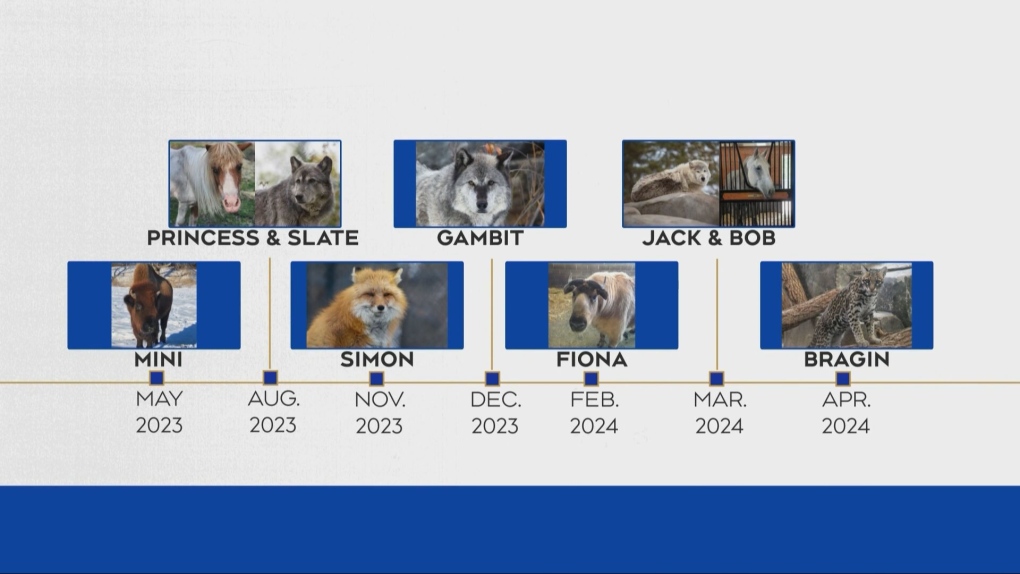'We always have a thoughtful process for that': The dark reality facing aging zoo animals
Anyone who visits Assiniboine Park Zoo can see empty or near-empty exhibits scattered throughout the grounds – spaces that previously served as homes for aging animals that have since passed away.
That includes one enclosure in the park’s Toucan Ridge area where Bragin the ocelot lived. The nearly 24-year-old cat came to Assiniboine Park Zoo in July 2011, but after his health took a turn for the worse last week, he was euthanized.
“He arrived as a middle-aged cat and he lived the duration of his golden years here at the zoo, well beyond the natural lifespan of an ocelot,” said Chris Enright, the zoo’s senior director of zoological operations.
 A timeline of animals that have recently died at the Assiniboine Park Zoo. (CTV News Winnipeg)
A timeline of animals that have recently died at the Assiniboine Park Zoo. (CTV News Winnipeg)
Since last May, at least 10 animals have died at the zoo, including three wolves. Now, only one lone wolf remains.
“We’re committed to that existing wolf for the duration of his lifespan, whatever that might be,” Enright said. “And at the conclusion, we’ll have a thoughtful approach and look at bringing in a new group of wolves after that.”
One expert said zoos like the one at Assiniboine Park should reconsider that approach and the role they play in Canadian society.
"Keeping wild animals for entertainment is really indefensible at this point, but there are other valid roles that they can play,” said Kaitlyn Mitchell, the director of legal advocacy at Animal Justice. “They could look to more of a sanctuary model, so taking in animals in need or playing more of a conservation role.”
As more and more animals age, conservationists are worried about a possible hunt for fresh blood.
“There's going to be extra pressure to take from the wild, which is not a good idea if the wild animals are themselves in decline,” said Barry MacKay, Animal Alliance of Canada’s Wildlife Issues Director.
In terms of its overall animal population, the Assiniboine Park Zoo said it’s not in decline despite the recent deaths.
“We're certainly committed to maintaining an animal population that is highly engaging for our guests, that connects people with conservation and really fosters caring,” Enright said.
When it comes to its ocelot exhibit though, Enright said they’ll be figuring out what’s next over the summer months.
“This summer we will go through our processes to decide, ‘Is another ocelot the right answer?’ or is a different species the right answer to really achieve the goals of having animals in human care,” he said.
CTVNews.ca Top Stories

W5 Investigates How a convicted con artist may have exploited Airbnb's ID checks in rental scams
In part two of a W5 investigation into landlord scams, correspondent Jon Woodward looks at how hosts on Airbnb may be kept in the dark about their guests' true identities – a situation that a prolific Canadian con artist appears to have taken advantage of.
'She will not be missed': Trump on Freeland's departure from cabinet
As Canadians watched a day of considerable political turmoil for Prime Minister Justin Trudeau and his government given the sudden departure of Chrystia Freeland on Monday, it appears that U.S. president-elect Donald Trump was also watching it unfold.
Canadian government to make border security announcement today: sources
The federal government will make an announcement on new border security measures after question today, CTV News has learned.
Two employees charged in death of assisted care resident who ended up locked outside building overnight
Two employees at an Oshawa assisted living facility are facing charges in connection with the death of a resident who wandered outside the building during the winter and ended up locked outside all night.
The Canada Post strike is over, but it will take time to get back to normal, says spokesperson
Canada Post workers are back on the job after a gruelling four-week strike that halted deliveries across the country, but it could take time before operations are back to normal.
Lion Electric to file for creditor protection
Lion Electric, a Quebec-based manufacturer of electric buses and trucks, says that it plans to file for creditor protection.
Tofino Harbour Authority closed due to standoff with 'squatter,' agency says
The Tofino Harbour Authority says it has shuttered its office in the coastal Vancouver Island community after what it describes as an escalating standoff with a squatter who has been occupying the harbour property for more than two years.
Canada's inflation rate down a tick to 1.9% in November
Inflation edged down slightly to 1.9 per cent in November as price growth continued to stabilize in Canada.
Transit riders work together to rescue scared cat from underneath TTC streetcar
A group of TTC riders banded together to rescue a woman's cat from underneath a streetcar in downtown Toronto, saving one of its nine lives.


































